Ancient. Obsolete. Dinosaur. Older than dirt. Old fashioned. These are a few of the terms, which have been used to describe…me! While I don’t believe they all apply, especially about being older than dirt, and just because I had a pet dinosaur when I was growing up doesn’t mean that I’m “that” old. I will readily admit though that I love the music from the mid to late 1960s, and when I do have the radio on in my pickup truck it is tuned to an oldies station. My favorite group from the 1960s was Peppermint Rainbow. Their song, “Will You be Staying After Sunday” is still my favorite song from that time period. (This is a poor quality video, but it’s the only known video of this group from the 1960s; they weren’t squat and fat.) I have a number of pictures on my office wall of many famous people that I know/knew, including the late Col. Rex Applegate, Roy Rogers, and Dale Evans, and many more. However, my autographed picture of Peppermint Rainbow sits on my desk, not on my wall. It is signed by Bonnie Lamdin, the lead singer of Peppermint Rainbow, and her sister, Pat Lamdin. Bonnie and I stay in touch with each other several times per year via e-mails. Without a doubt, I’m Peppermint Rainbow’s biggest fan. I even hear from the lead guitarist, Doug Lewis, now and then. He is still in the music game with his group, The New Monopoly.
If I could go back in a time machine and was allowed to take a pill that would make me 18 years old again, I would jump on it and never look back (forward?) to the future. I admit to being somewhat old-fashioned in many things, and change comes hard for me, real hard. Yep, I miss the “old days”.
Now, while I might resemble some of the comments about my age, though I certainly hope that I’m not obsolete, I hope I still have a few years left in me, where I can make some contributions to society and to my life. All of this leads to the purpose of this article, and that is reviewing a revolver– the Ruger GP100 .357 Magnum revolver, to be exact. Many SurvivalBlog.com readers have contacted me and asked me to do some reviews on revolvers. I’m guessing these folks are my age or maybe older. Sadly, I turn 65 later this year. These readers may be like myself, in that they cut their teeth on revolvers back in the 1960s when it was “the” gun to have. The few semiauto handguns around, like the 1911 and the Browning Hi-Power, were some of the most reliable semi’s out there, but choices in ammo were mainly in FMJ, which were not the best for self defense. So, everyone gravitated to revolvers, with JHP ammo.
I carried revolvers while working as a private investigator and doing private security work back in Chicago, IL. Most of the time I carried a 4” Bbl S&W Model 586 or a Ruger Service six, both .357 Mag chambered. At times, I also carried a S&W Model 10 with a heavy barrel, and on my ankle was a backup revolver– either a S&W Model 36 or a Cold Detective Special. So, I’m well aware of the use and deployment of revolvers. Even during some time as a police officer, I still carried a revolver as a backup, again, in an ankle holster. To this day, I can still be “caught” carrying a little snubby revolver in an ankle holster from time-to-time!
Many younger readers might poo-poo the use of revolvers in today’s busy world of semiauto handguns, thinking that the revolver is ancient, old fashioned, or even obsolete. If you believe that then your thinking might be obsolete, if you ask me. Sure, in some cases and perhaps many, a revolver isn’t the best choice for self defense. Then again, it depends on where you’re standing at the time. Working police officers are often outgunned on the mean streets of American these days, even when armed with a GLOCK that can carry 17-rds of JHP 9mm ammo. Fortunately, many police officers have access to backup by other officers, but some don’t! For them, I say carry a semiauto handgun with two to four spare magazines.
Enter the revolver today! I’ve often said that the best (if there is such a thing) handgun for survival, on the street or in the wilderness, is some kind of stainless steel, 4” Bbl .357 Magnum revolver, loaded with good JHP ammo. One of the benefits of having a revolver in .357 Mag is that you can also shoot lower-powered .38 Spl ammo and use it for plinking and target practice, instead of always burning up the most expensive .357 Mag ammo.
The Ruger GP100 is a .357 Mag revolver that perfectly fits my criteria for the above handgun for survival. We have a 4.20-inch barrel, lugged with a fully adjustable rear sight, elevation and windage, in stainless steel finish with a brushed satin for a low-glare to it, but it still will fight off the elements. The gun is heavy. It weighs in at 40 oz. Compared to many semiauto handguns made with polymer frames, many will think the GP100 is too heavy. It’s not, especially when shooting full-power .357 Mag loads. .38 Spl loads are a real pussycat to fire in this massive gun. The current GP100 comes with a Hogue Monogrip; earlier models had a combination of wood and rubber grips that many didn’t like. I love the Hogue Monogrip with the finger grooves. The front sight on the GP100 is all black; however, it is easily changed out to one of several different colors. I’m awaiting a front sight with a red insert in it that is easier for my aged eyes to pick up.
The GP100 has a triple locking cylinder that is locked to the frame at the front, rear, and bottom. We are talking super-strong lock-up, for more reliable functioning, shot after shot. Like previous double-action revolvers from Ruger, the takedown is integrated into several sub-assemblies and requires no special tools to completely disassemble the gun for major cleaning and/or parts repair.
Quite often, when I’m haunting my local FFL, Fast Cash in Lebanon, OR, they get swamped with customers, and I step behind the counter to help them out. Many customers, especially “ancient” ones like myself, ask me about the “best” .357 Mag revolver that they can own. I always steer them to a Ruger GP100, if there is one in the display case. I get the same thing from many who reply, “Oh, you’re only saying that, because you work here.” I inform them that I do not work there and am just helping out. I have no vested interest in Ruger firearms, nor do I make a commission on the guns I help sell at the shop.
Yes, there are many other great 4” Bbl .357 Mag revolvers out there, and I have no problem with someone choosing a S&W or a Dan Wesson, or any other quality revolver. However, in my humble opinion, the GP100 just might be the strongest .357 Mag revolver being made; if it’s not the strongest, then it is in the top two or three. And, the sheer simplicity of the sub-assemblies, which consists of the inner workings of the GP100, well, there just isn’t much to go wrong with this gun. Spare parts? I don’t keep any on hand for this gun, other than the different front sight I ordered for my gun.
One of the nice advantages of a good double/single action revolver is the fact that you can fire it double-action for self-defense, or you can cock the hammer and fire it single-action, if need be, when attempting to take game with it. I previous reported, in another article, where I took a good-sized black bear with a 4” Bbl .357 Mag revolver. I also took a badger with the same gun, and he was hard to kill,even with 125-JHP loads. It took six shots to finally anchor him. They are tough for their size. However, taking game like deer, at reasonable distances with good shot placement, isn’t a problem. The deer in my area are rather small black tail and go down with one to the boiler room. Again, I’d use a JHP, probably a heavier 158-gr load or even go with a 180-gr Hard Cast load.
I had an outstanding assortment of .38 Spl and .357 Mag ammo to run through my GP100. From my friends at Black Hills Ammunition, I had their .38 Spl. 125-gr JHP +P and their 148-gr Match HBWC and .357 Mag. I had their 125-gr JHP, 158-gr JHP and their Cowboy load that is a sedate 158-gr CNL load moving at 800-FPS. From the nice folks at Buffalo Bore Ammunition, I had their .38 Spl 158-gr Hard Cast +P Outdoorsman load, 125-gr LV JHP +P, 110-gr Barnes, all-copper hollow point standard pressure load, and the same in +P, in .357 Mag. I had their 180-gr Hard Cast Outdoorsman load, 158-gr JHC, 125-gr JHC, 125-gr Barnes XPB all-copper hollow point, and lastly their 140 Barnes XPB all-copper hollow point. From the folks at Double Tap, I had .38 Spl 148-gr full wadcutter Match load, 110-gr DT Lead Free, and 110-gr Controlled Expansion load, and in .357-Mag I had their 110-gr DR. Lead Free, and 180-gr Hard Cast solid load.
I don’t know when I’ve had such a variety of different brands and types of ammo to run through a gun for an article. The Ruger GP100 was up to the task though. I did have a box of 158-gr SWC .357 Mag ammo that was given to me by the gun shop I haunt, and they don’t know who loaded it or anything, but I knew that no matter what, the GP100 could handle it. Needless to say, my shooting session with the GP100 covered many days, over several weeks, and I did have some volunteers helping me. There is never a lack of volunteers when the ammo is free and gun is provided!
The GP100 sample I received from Ruger had the rear sight completely as high as it would go, when I first fired it. All rounds were close to a foot above the target at 25 yards. It took some cranking to get the rear sight down for a 25-yard zero, with 158-gr loads. The windage was dead-on though, so that was the good news. I don’t like to shoot a lot of .38 Spl ammo through a revolver chambered in .357 Mag, for the simple reason that if you fire a lot of the shorter .38 Spl ammo in a .357 Mag gun, it tends to make extraction of the longer .357 Mag brass a little harder. It doesn’t matter how much you scrub the chambers; if you fire a lot of the shorter .38 Spl brass in the gun, this happens, so I limit any .38 Spl ammo in any .357 Mag I shoot. As a rule, this isn’t a problem. However, it can be, so be advised.
The 158-gr lead SWC reloads that were given to me were pretty hot, and they simply wouldn’t group. No matter how hard I tried, they just were making holes all over the target, and it did lead-up the barrel. It took a lot of scrubbing to get the lead out of the barrel, but the GP100 handled this hot load just the same. As mentioned, the GP100 is a super-stout .357 Mag revolver, perhaps the strongest on the market.
At 25 yards, there isn’t a lot of difference in the point of aim or point of impact between the 125-gr bullets and the 158-gr bullets from any of the makers. The impact point with the heavier 180-gr Hard Cast loads was shooting about an inch or so higher than the rest of the loads, and the 110-gr loads were easily an inch lower than the 125 and 158 grain bullets. Still, that’s not that big of a deal. In all my years using a handgun for hunting, any kind of hunting– small or big game– I’ve never taken a shot beyond 50 yards, and most were closer than that. The sights on a revolver determines how well you can hit a target at longer distances; smaller bead front sights allow for a much better sight picture for longer ranger shooting. The sights on the GP100 are pretty much standard in size, and at 100 yards it pretty much covers the entire body of a small deer, so you don’t have a precise aiming point.
Now, with the above said, I used to vacation in Colorado Springs, CO many years ago when I would hike and camp out in the mountains of the area. I usually packed either a .357 Mag revolver or a .44 Mag revolver during these treks. I could take either of the above guns, sit on one mountain, shoot across to a big boulder on another mountain that was roughly 600 yards away, and consistently hit the rock, once I got on my game. However, shooting at any game at that kind of distance is stupid!
My accuracy testing was all conducted at 25 yards with me resting the GP100 on a sleeping bag across the hood of my pickup, and all shots were in the single-action mode to wring out the most accuracy possible. Every thing I shot, outside of those unknown reloads, gave me groups around two inches, if I did my part. Some groups were a little bigger, some a little smaller. The winner in the accuracy department was the Black Hills Cowboy load. Those conical lead 158-gr bullets moving along at 800-FPS would give me groups of about an inch and a half, if I did my part. I was surprised! I thought one of the other loads would have done better. I like the 125-gr JHP loads for self defense against critters with two legs. For 4-legged critters, the 158-gr or 180-gr Hard Cast loads are the way to go. Still, I wasn’t disappointed in the performance of the GP100 and any of the loads. I liked the Black Hills 148-gr HBWC and the Double Tap 148 WC loads; they were both hot on the heels of the Black Hills 158-gr Cowboy load.
Now, picking one load for hunting or on the hiking trail is a tough one! I think it is a toss-up between the Buffalo Bore 180-gr Hard Cast load and the Double Tap Hardcast Solid. Both give the penetration you will need on dangerous game. I know some hunters who have used the Buffalo Bore 180-gr Hard Cast load on elk. Yes, elk! And, they reported that it shot completely through an elk standing broadside, and I have no reason to doubt their claims. There is an over abundance of black bears in Oregon, so that is the load I’d use on them if I were hunting them with a .357 Mag revolver. For thin-skinned game, any of the .357 Mag JHP loads in the 158-gr bullet weight would do the job on the likes of mountain lions.
I don’t carry the GP100 concealed, nor do I currently have a holster that will conceal this gun. It is large, but it is concealable with the right clothing and holster. I simply use an Uncle Mike’s size 2 ballistic Nylon holster for open carry in the boonies, and I have two speed loaders in a double speed loader case for fast reloads, not that I’ve ever had to speed load any revolver, ever!
BTW, the double-action trigger pull is super, super smooth. There’s not a hitch of glitch anywhere along the entire trigger pull. It broke at about 11 lbs and is smooth, smooth, smooth.
Is the revolver design “old”? You bet. Is it “ancient”? Maybe just a little bit. Is it “old fashioned”? Well, that depends on who you talk to. Is it a “dinosaur”? Well, I don’t think so, and some of the bigger calibers we have today could probably bring down some of the smaller dinosaurs. Now, the big question is, is the revolver “obsolete”? I don’t think so; not in the least. If forced into some kind of survival situation, be it city or wilderness, the GP100 in .357 Mag would do quite nicely for self defense against two-legged and four-legged threats, with the right ammo. It will also bring home something for the pot for your dinner, again with the right loads.
I don’t believe that I’m quite “obsolete” just yet. I think I have a few more years left, and I can contribute something to society in some way, shape, or form, and I don’t believe for one second that a good .357 Mag revolver with a 4” Bbl is obsolete. It still has a lot to offer a person. Especially if they can only own one handgun, this may be the way to go, in my humble opinion.
– Senior Product Review Editor, Pat Cascio










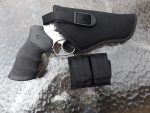
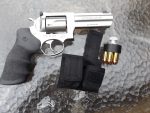
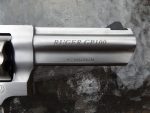

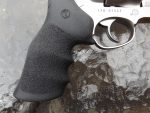
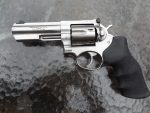
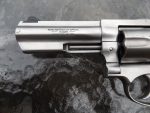
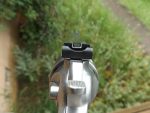
Better late than never to compliment you on this excellent post. My wife and I primarily shoot revolvers and we really like this Ruger.
The only issue I have had is with the front sight, a rugged but all black ramp that makes dark targets hard to acquire. The company finally offers two choices out of the box with fiber-optic front sights and 4.25 inch barrels: the Match Champion, with a very smooth trigger pull and a version of your gun, with the rosewood/rubber grips and FO sights. For my eyes and budget, that enhanced GP will be our next revolver.
Are you not aware that for about $12 you can change the ramp front sight in about 2 seconds to a orange ramp,or for a little more a fluorescent.